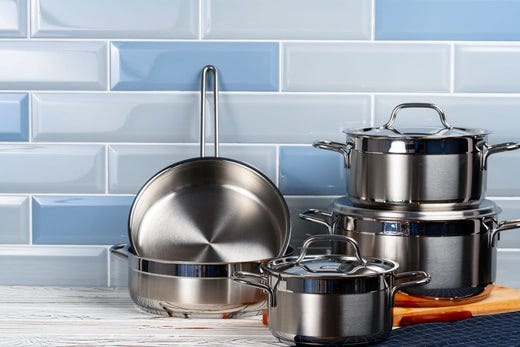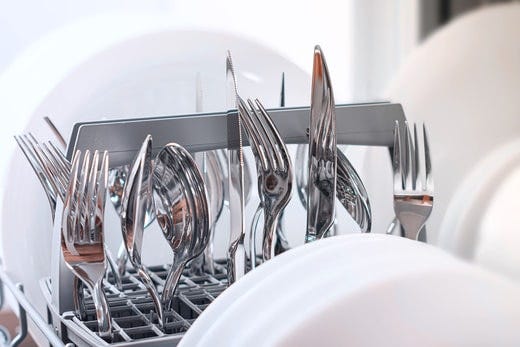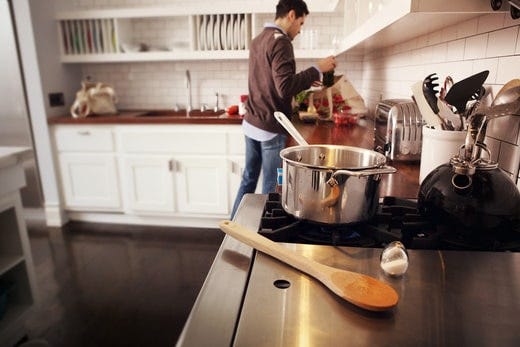
Can Stainless Steel Go In The Dishwasher?

Stainless steel is a common and popular material found in almost every kitchen. It is a sleek and modern looking material which has gained great popularity over the last few years, but has been used in kitchens around the world since the 1910s. It is a steel alloy that, aside from being beautiful, is also versatile and practical. It is a long-lasting metal which is affordable and easy to sterilise. Your kitchen is almost certainly home to a few stainless steel items or fittings - whether it’s your kitchen sink, your pots and pans, your toaster, microwave, or even your knives and forks.
But can stainless steel go in the dishwasher? Not only is it beautiful and practical, but it’s also (usually) dishwasher safe. In this article, we’ll explain what stainless steel is and how it works. We’ll also go over some of the stainless steel objects that, while being dishwasher safe, do typically require a little more care than other items. In the event your stainless steel is not dishwasher safe, you’ll also learn how to clean your stainless steel pans and pots by hand, and about the range of stainless steel-friendly dishwashing detergents from Finish.
What is Stainless Steel?
Stainless steel is an alloy metal, made by combining chromium and nickel. Unlike regular steel which is highly susceptible to rusting, stainless steel is a lot tougher thanks to the protective chromium oxide layer on the surface of the metal. It’s important to understand what kinds of stainless steel you have in your kitchen, as this can make it easier to prevent your cookware from becoming damaged over time.
High quality stainless steel cookware typically comes in one of two grades- 18/8 or 18/10. These numbers refer to the amounts of different metals combined in the steel alloy- the first number refers to the amount of chromium as a percentage, while the second number refers to the amount of nickel. Of all the varieties of stainless steel, high quality 18/10 and 18/8 items are often the easiest to damage. While they can normally be washed in the dishwasher with no issues, you’ll need to be careful not to cause any damage to the rust-resistant surface.
18/0 is another grade of stainless steel, and is usually used for items that aren’t heated. 18/0 products contain no nickel, making them completely dishwasher safe.
Cleaning Stainless Steel by Hand
Some stainless steel items are more likely to be dishwasher safe than others. Items that are stainless steel clad, like some saucepans or pots, are more likely to be damaged by your dishwasher than a pure 18/0 grade cutlery set. Some stainless steel items will be labelled as ‘dishwasher safe’, while others are not. In these cases, you can clean your items using any mild dishwashing liquid and a gentle sponge. Never use a scourer on your stainless steel items, or you may damage the rust-resistant surface. You should also avoid using strong detergents on your stainless steel items, as they can contain harsh chemicals that may damage your cookware over time. Always make sure to rinse any food off your items after use, and dry immediately after washing, to avoid leaving water spots and damaging the surface.
How to Clean Stainless Steel Pots and Pans in the Dishwasher
When you’re cleaning your stainless steel pans and other cookware, the first thing to check is whether or not your items are dishwasher safe. Most stainless steel is, but if your pots and pans are not, it is best to opt for handwashing to avoid any damage.
If they are safe to go in the dishwasher, scrape off any food debris. Check your dishwasher’s instruction manual to find out where to place your pots and pans to get the most thorough clean. When you set your dishwasher mode, choose one that is most appropriate for pots and pans. If your dishwasher has a specific setting for pots and pans, choose this cycle- if not, your regular cycle choice will also work. Try premium quality dishwashing tablets, like Finish Ultimate Plus, which will clean your dishes.
How to Clean Stainless Steel Water Bottles in the Dishwasher
As with all stainless steel items, when it comes to your water bottles and travel cups, check if they are dishwasher safe before throwing them into your next cycle. As a general rule, most mugs and bottles that are uninsulated and uncoloured are dishwasher safe. If your bottle is insulated or is coloured, your dishwasher could cause damage to parts of your items like coloured coatings. In these cases, it is safer to hand wash to avoid any potential damage.
When loading your stainless steel bottles into the dishwasher, remove the cap and any other inserts before placing your bottle upside down. Like with your pots and pans, facing the dirtiest part of your bottles and mugs down will ensure the most thorough clean. You should also try to place your stainless steel water bottles and mugs in the top rack of your dishwasher, so they can be washed at a slightly cooler temperature. Make sure you fully dry any stainless steel mugs or water bottles after they have been cleaned in your dishwasher. You can air dry, or use a cloth.
How Finish Can Help
If you are using your dishwasher to clean your stainless steel items, it’s recommended to use high-quality dishwashing detergents. Try the Finish range of tablets and rinse aids to clean your stainless steel items. Finish Ultimate Plus Dishwasher Tablets are a great option for tackling tough burnt-on stains. We recommend always drying your stainless steel items once they are clean to avoid water spots in the future. Try Finish Rinse & Shine Aid to help fight water spots and dry your dishes.



